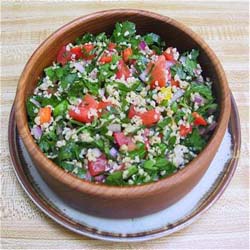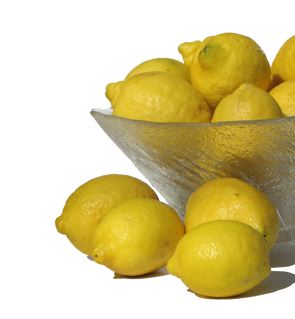
This salad favorite is perfect for late “springtime” or else “summertime” enjoyment. We look forward to eating every year (especially at a “BBQ” type event).
Once mint is again growing in the garden, it is time to make Tabbouleh!
Tabbouleh is a classic chopped vegetable salad of which there are many variations, depending upon where in the Mediterranean or Arab/Middle Eastern world the recipe version originated from.
Photograph ©Stephanie B-H/SensoryNutrition/US12
This vegetable salad is built on lots of flat leaf parsley, some type of scallions or sweet onions, varying amounts of rehydrated bulgur wheat (translation from Lebanese would be burghul/burghol), and a dressing based on olive oil and lemon juice.
From there, many interpretations of what else should be in the salad abound. In a way, it is a “modular” salad since as long as you pick something from at least a minimum number of categories and avoid having soggy bulgur wheat or other grain in it, you can’t go wrong and you can make the salad your own in the end!
The Lebanese people in particular take great pride in their Tabbouleh versions and actually even have a National Tabbouleh Day, organized by Lebanon’s first organic farmers market in Beirut and now celebrated on the first Saturday in the month of July.
In the Greek/Turkish/Arab/Middle Eastern world, Tabbouleh is often served as part of Meze/Mezze/Mezzeh/Mazza, involving very large platters/trays containing various size portions of a number of food items (cold or hot, savory or spicy) as in appetizer size “Mazza for two” or in serving dishes set out to feed an entire table of family members and/or guests where each person has their own personal smaller plate.

The use of LOTS of parsley makes this salad not only quite a healthy choice, but also a great palate cleansing choice. Lemon juice along with parsley does wonders to refresh any palate.
Be sure to use FRESH lemon juice and not bottled lemon juice! Thinner skinned lemons will usually yield more juice per lemon than thicker skin lemons will.
(Lemons image courtesy of lusi at rgbstock.com)
Coming from an Italian heritage, our preference in this instance for this salad is to use flat leaf Italian parsley. Larger parsley leaves can be quickly picked off of stems and then we stack the leaves and use handy separating style kitchen shears to cut them up.
In the recipe version featured today, we also included some fresh mint, sweet colored peppers, celery leaves & stalks, Roma tomatoes, finely ground allspice & cinnamon, and finely ground pepper. We love the use of finely ground allspice & cinnamon in this salad and urge you not to leave those spices out.
We also urge you to use fresh mint in this salad as it does make a difference in the final flavor profile for this salad served at room temperature only after the flavors have mingled in the refrigerator for at least 4-6 or so hours or overnight.
Since smaller, assorted color sweet peppers were in the market this week, we went with those. Not all cultures add the sweet peppers to this salad, but we enjoy the flavor, color, and nutritional value the sweet peppers contribute.
Other recipe versions might use seedless cucumbers, etc., in the salad.
Since we didn’t have scallions handy at the moment, we went with some minced red onion instead. You have some flexibility in your allium choice–just be sure to use a “sweeter” type of allium, but definitely NOT garlic. Scallions/green onions are preferable, but other substitutions could include Vidalia onions, sweet Peruvian onions, etc.
We also love tomatoes in this recipe. Although some folks like to use cherry tomatoes, halved, we like to remove the seeds from Italian Roma tomatoes instead. Whatever tomatoes you might use, just make sure they are really ripe before adding them to this salad.
Another variation of this recipe is to add a bit of fat-free crumbled feta cheese which we have done to have a rounded out snack/luncheon meal. We add that at the last minute to the portion we have placed in a personal salad bowl as shown in the photo above. Note that often we don’t add salt to the recipe, but the sodium content of the fat-free feta cheese can be appealing in this dish.
We’ve seen recipes where there was an attempt to substitute couscous for the fine bulgur wheat, but our preference is for the pre-cooked and dried, fine grain bulgur wheat (don’t buy medium or coarse grain bulgur wheat meant for soups and stews to use in this salad recipe). We’ve always been able to find the pre-cooked and dried fine grain bulgur, so it saves a lot of time when re-constituting it for a salad dish. The Lebanese people will often actually rehydrate a smaller quantity of fine bulgur wheat in lemon juice instead of water.
When delis, etc., in the USA make this type of salad, they tend to use much more grain proportionally than is desirable, so be aware of that. This should be primarily a vegetable salad with a little grain, not vice-versa.
For a cool summertime salad, try some refreshing Tabbouleh salad–it really is worth the effort to make your own!
TABBOULEH SALAD
Makes 6 salad course size portions
INGREDIENTS:
•Grain:
- 1 cup Fine Grain Bulgur Wheat (look for the pre-cooked and dried, which is sold in most bulk food sections in grocery stores today); soaked in 2 cups Cold Water (see below)
•Vegetables:
(except celery, red bell pepper, and tomatoes): Very finely mince (1/8″) these using a French Chef’s knife, kitchen shears, or a hand operated chopper or electric food processor, then combine these together in a medium bowl:
- 1/2 bunch Green Scallions
- 2 large bunches Italian or Curly Parsley, Leaves only (no stems–save washed & dried stems in the freezer for use in soups, etc.)
- 2 tbsp. Mint Leaves or 1 tsp dried mint;
•Add:
- 1 sm. Red Bell Pepper, cored, seeded, minced (1/8″) or sm. diced (1/4″)
- 2 stalks Celery, minced ( 1/8″) or small diced (1/4″)
———————————————————————————————————————
- Tomatoes (preferably Roma/plum type, seeded): Cut 4 medium into a 1/4″ small dice and set aside in a separate small bowl
———————————————————————————————————————
DRESSING: Whisk these ingredients together until smooth:
- 2 Tbsp. Olive Oil (preferably extra virgin type as quality of flavor is critical here)
- 1/4 cup Lemon Juice, Freshly Squeezed
- 1/4 tsp Ground Allspice
- 1/4 tsp. Ground Cinnamon
- 1/2 tsp Salt (optional)
- 1/4 tsp freshly Ground Pepper
———————————————————————————————————————
METHOD:
- Soak the bulgur wheat in 2 cups of cold water for at least 15 minutes and usually up to 30 minutes. Place the softened bulgur wheat in an ample size fine mesh colander and allow to drain dry (about 15 min.) or pat/squeeze dry (you do NOT want a wet, waterlogged grain here). Set aside the drained bulgur wheat in a large bowl. NOTE: The Lebanese often use less of the fine bulgur wheat (only 1/3-1/2 cup instead of 1 cup) and they don’t soak the fine bulgur wheat in water; instead, they soak the smaller quantity of fine bulgur wheat (just 1/3-1/2 cup) in the juice of 4-5 fresh lemons since the excess juice will simply become part of the dressing. Since the bulgur wheat is already cooked, cold water works fine vs. hot water some recipes may call for.
- Pour the whisked dressing mixture over the drained bulgur wheat.
- Add the vegetables (except for the diced tomatoes) and toss mixture together thoroughly. Lastly, gently blend in the diced tomatoes. (NOTE: WE PREFER TO ADD THE TOMATOES JUST 15-30 MIN. BEFORE SERVING)
- Refrigerate mixture 4-6 hours or preferably overnight to allow the flavors to meld.
- Serve by allowing salad to slightly warm up to room temperature for best flavor.

